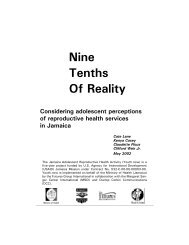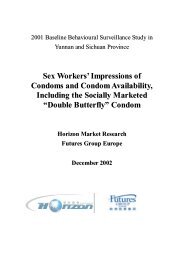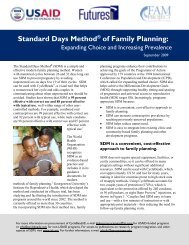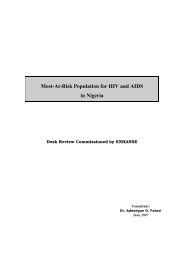Health Policy Issues and Health Programmes in ... - Amazon S3
Health Policy Issues and Health Programmes in ... - Amazon S3
Health Policy Issues and Health Programmes in ... - Amazon S3
- No tags were found...
Create successful ePaper yourself
Turn your PDF publications into a flip-book with our unique Google optimized e-Paper software.
Household <strong>Health</strong> Care Costs <strong>in</strong> Indiachronic illness. Similarly, Kulkarni <strong>and</strong> Chitan<strong>and</strong> (1994) f<strong>in</strong>d that, <strong>in</strong> Maharashtra, the treatmentcost for a major illness is 12-15 times greater than the cost for a m<strong>in</strong>or illness.Several other studies present <strong>in</strong>terest<strong>in</strong>g f<strong>in</strong>d<strong>in</strong>gs about the cost of treatment. Studies byKrishnan (1994) f<strong>in</strong>d that (1) the cost of treatment is higher <strong>in</strong> states where the public health<strong>in</strong>frastructure is least developed; (2) poor patients pay more for health care <strong>and</strong> bear the higherburden of treatment (See section on <strong>Policy</strong> <strong>Issues</strong>); (3) hospitalization <strong>in</strong>creases the <strong>in</strong>tensity ofpoverty for poor families; (4) treatment <strong>in</strong> private hospitals, either as an <strong>in</strong>-patient or an outpatient,is expensive <strong>and</strong> out of reach of the poor; <strong>and</strong> (5) the burden of treatment is the highestfor women, due to the <strong>in</strong>accessibility of affordable services.Another study by Gumber <strong>and</strong> Berman (1997) f<strong>in</strong>ds that (1) the <strong>in</strong> patient treatment tends to bequite expensive <strong>and</strong> burdensome; (2) for both <strong>in</strong> patient <strong>and</strong> out patient care, the burden tendsto be higher <strong>in</strong> rural areas as most rural patients have to travel to the health care facilitieslocated <strong>in</strong> urban areas; (3) <strong>in</strong> cases of no <strong>in</strong>surance coverage <strong>and</strong> longer duration of treatment,the f<strong>in</strong>ancial burden of treatment on households was much higher if the patient was treated <strong>in</strong> apublic sector <strong>in</strong>stitution; (4) there exist <strong>in</strong>ter-state differentials <strong>in</strong> the burden of treatment whichwere more pronounced for <strong>in</strong>-patient treatment; <strong>and</strong> (5) the burden of treatment is <strong>in</strong>verselyproportional to monthly per capita expenditure.Table 1. Per Capita Annual <strong>Health</strong> ExpenditureStudy Scope of Study Per Capita <strong>Health</strong>Expenditure, Annual(<strong>in</strong> rupees)National Service System42nd Round, 1992 National 248Duggal <strong>and</strong> Am<strong>in</strong>, 1989 Jalgaon 182George, 1997 Madhya Pradesh 299Kulkarni <strong>and</strong> Chitan<strong>and</strong>, 1994 Maharashtra 415A few studies attempted to estimate the percapita annual health expenditure (NSSO,1992; Duggal <strong>and</strong> Am<strong>in</strong>, 1989 [Jalgaon];George, 1997 [Madhya Pradesh]; <strong>and</strong> Kulkarni<strong>and</strong> Chitan<strong>and</strong>, 1994 [Maharashtra]). Asshown <strong>in</strong> Table 1, estimates range from Rs182 to Rs 415 per capita.Only the Madhya Pradesh <strong>and</strong> Jalgaonstudies have directly estimated the share ofhousehold health expenditure of the total <strong>in</strong>come/expenditure. Other studies calculate thisshare <strong>in</strong>directly. The proportion ranges between 5% <strong>and</strong> 15% <strong>in</strong> the Bombay (Yesudian, 1990)<strong>and</strong> National Council for Applied Economic Research (NCAER) (Sundar, 1992) surveys,respectively. The National Sample Survey (NSS) 1992 reports that the share of health expenditureof total <strong>in</strong>come is 5.7%. None of these studies have provided estimates of the total annualamount spent on RCH services.142Only two studies (Sujata Rao et al., 1997; Duggal <strong>and</strong> Am<strong>in</strong>, 1989), collected <strong>in</strong>formation regard<strong>in</strong>gthe source of money that was used by the household to pay out-of-pocket costs. The study bySujata Rao et al. (1997) <strong>in</strong> Hyderabad reports that about 50% of the families with at least onemember with a health problem f<strong>in</strong>anced their health care payments with loans or distress sale oftheir assets. The median amount of loan was Rs 4000–5000, for which monthly <strong>in</strong>terest between3%-5% was paid. Accord<strong>in</strong>g to Duggal <strong>and</strong> Am<strong>in</strong> (1989), 1.3% of all episodes of illness were







